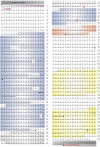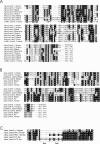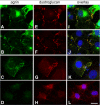C. elegans agrin is expressed in pharynx, IL1 neurons and distal tip cells and does not genetically interact with genes involved in synaptogenesis or muscle function
- PMID: 17710131
- PMCID: PMC1939731
- DOI: 10.1371/journal.pone.0000731
C. elegans agrin is expressed in pharynx, IL1 neurons and distal tip cells and does not genetically interact with genes involved in synaptogenesis or muscle function
Abstract
Agrin is a basement membrane protein crucial for development and maintenance of the neuromuscular junction in vertebrates. The C. elegans genome harbors a putative agrin gene agr-1. We have cloned the corresponding cDNA to determine the primary structure of the protein and expressed its recombinant fragments to raise specific antibodies. The domain organization of AGR-1 is very similar to the vertebrate orthologues. C. elegans agrin contains a signal sequence for secretion, seven follistatin domains, three EGF-like repeats and two laminin G domains. AGR-1 loss of function mutants did not exhibit any overt phenotypes and did not acquire resistance to the acetylcholine receptor agonist levamisole. Furthermore, crossing them with various mutants for components of the dystrophin-glycoprotein complex with impaired muscle function did not lead to an aggravation of the phenotypes. Promoter-GFP translational fusion as well as immunostaining of worms revealed expression of agrin in buccal epithelium and the protein deposition in the basal lamina of the pharynx. Furthermore, dorsal and ventral IL1 head neurons and distal tip cells of the gonad arms are sources of agrin production, but no expression was detectable in body muscles or in the motoneurons innervating them. Recombinant worm AGR-1 fragment is able to cluster vertebrate dystroglycan in cultured cells, implying a conservation of this interaction, but since neither of these proteins is expressed in muscle of C. elegans, this interaction may be required in different tissues. The connections between muscle cells and the basement membrane, as well as neuromuscular junctions, are structurally distinct between vertebrates and nematodes.
Conflict of interest statement
Figures










Similar articles
-
C. elegans dystroglycan DGN-1 functions in epithelia and neurons, but not muscle, and independently of dystrophin.Development. 2006 May;133(10):1911-21. doi: 10.1242/dev.02363. Epub 2006 Apr 12. Development. 2006. PMID: 16611689
-
Agrin binds to the nerve-muscle basal lamina via laminin.J Cell Biol. 1997 May 5;137(3):671-83. doi: 10.1083/jcb.137.3.671. J Cell Biol. 1997. PMID: 9151673 Free PMC article.
-
DYC-1, a protein functionally linked to dystrophin in Caenorhabditis elegans is associated with the dense body, where it interacts with the muscle LIM domain protein ZYX-1.Mol Biol Cell. 2008 Mar;19(3):785-96. doi: 10.1091/mbc.e07-05-0497. Epub 2007 Dec 19. Mol Biol Cell. 2008. PMID: 18094057 Free PMC article.
-
Functions of agrin and agrin-related proteins.Trends Neurosci. 1993 Feb;16(2):76-81. doi: 10.1016/0166-2236(93)90021-d. Trends Neurosci. 1993. PMID: 7680504 Review.
-
Nerve, Muscle, and Synaptogenesis.Cells. 2019 Nov 16;8(11):1448. doi: 10.3390/cells8111448. Cells. 2019. PMID: 31744142 Free PMC article. Review.
Cited by
-
The Caenorhabditis elegans SMOC-1 Protein Acts Cell Nonautonomously To Promote Bone Morphogenetic Protein Signaling.Genetics. 2019 Feb;211(2):683-702. doi: 10.1534/genetics.118.301805. Epub 2018 Dec 5. Genetics. 2019. PMID: 30518528 Free PMC article.
-
Basement Membranes, Brittlestar Tendons, and Their Mechanical Adaptability.Biology (Basel). 2024 May 24;13(6):375. doi: 10.3390/biology13060375. Biology (Basel). 2024. PMID: 38927255 Free PMC article. Review.
-
Genome-wide functional analysis of CREB/long-term memory-dependent transcription reveals distinct basal and memory gene expression programs.Neuron. 2015 Jan 21;85(2):330-45. doi: 10.1016/j.neuron.2014.12.029. Neuron. 2015. PMID: 25611510 Free PMC article.
-
Conservation and Innovation: Versatile Roles for LRP4 in Nervous System Development.J Dev Biol. 2021 Mar 14;9(1):9. doi: 10.3390/jdb9010009. J Dev Biol. 2021. PMID: 33799485 Free PMC article. Review.
-
Basement Membranes in the Worm: A Dynamic Scaffolding that Instructs Cellular Behaviors and Shapes Tissues.Curr Top Membr. 2015;76:337-71. doi: 10.1016/bs.ctm.2015.08.001. Epub 2015 Sep 12. Curr Top Membr. 2015. PMID: 26610919 Free PMC article. Review.
References
Publication types
MeSH terms
Substances
LinkOut - more resources
Full Text Sources
Molecular Biology Databases
Research Materials

